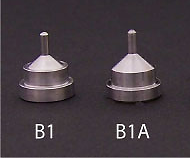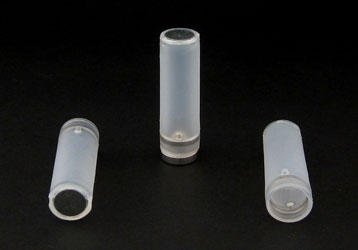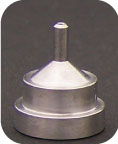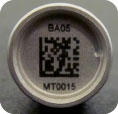 Loading... Please wait...
Loading... Please wait...Categories
- Home
- Lab Supplies
- Goniometer Bases
- Goniometer Base B1
Goniometer Base B1
Goniometer Base Styles
The B1 style goniometer base is modified from the most common base style by adding a 2 mm diameter extension to capture MicroRT capillaries. This goniometer base has the flat "ledge" used by grippers in, e.g., SSRL’s Stanford Automounting System. It can be used with any length MicroMount or nylon loop mount, and is precision machined from 416 stainless steel.

Base style B1A can also capture MicroRT capillaries and can be used with any length MicroMount or nylon loop mount. This goniometer base is precision machined from 416 stainless steel.
Base B1A has the ledge-free conical shape used by grippers in ALS-style automounters. Use base B1A at LBNL's Berkeley Center for Structural Biology, with the PXRR automounter at Brookhaven lab's NSLS, at SER-CAT and at CHESS.
Optional Goniometer Base Cryovial

CryoVials help keep your sample cold during transfer from a dewar to a cold gas stream. They also provide protection against sample damage or loss due to sloshing of liquid nitrogen within a storage dewar.
Mitegen's magnetic CryoVials are designed to meet the Europe's SPINE standard and are compatible with all earlier cryovial designs used in North America and Asia.
They have a ring magnet at the open end to attach to a goniometer base (cap), and a magnetic steel ballast at the sealed end to attach to SPINE automounters. They are compatible with all of Mitegen's goniometer bases, all other commercial goniometer bases (not just SPINE bases), with all cryovial handling tools, and with all automounters that require vials.
Mitegen's vials are designed specifically for protein crystallography. The translucent polymer used in our vials has excellent dimensional stability at temperatures between T=300 K and 77 K, which is important for reliable handling.
The ring magnet in our vials has been carefully chosen so that the vial attaches strongly to commercial goniometer bases, but not so strongly that the base releases from the vial before the vial releases from automounter magnets. These two design features resolve issues with existing commercial vials.
High Throughput Goniometer Bases
Features:
- Laser engraved 2D and alphanumeric barcode.
- Compatible with MicroRT capillaries for room temperature screening and crystal dehydration studies.
- Can be used with all crystal mounts/loops, including MicroMounts, MicroLoops, MicroGrippers and MicroMesh.
- Designed for use with SSRL/SAM style robotic sample changers.
- Use with 19 mm length rods.



